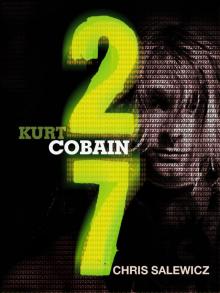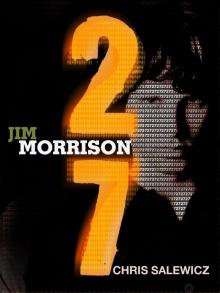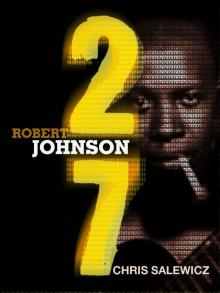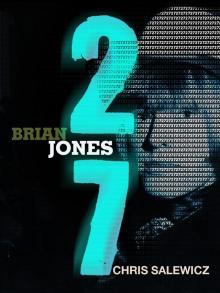- Home
- Salewicz, Chris
27: Brian Jones Page 2
27: Brian Jones Read online
Page 2
Brian’s weekend trips to London, inevitably involving staying up late jamming with Alexis, frequently left him exhausted. After missing Monday work one too many times, he was fired. Instead, he took a job as a bus conductor. Inevitably sacked from that employment, he took a more appropriate position, working behind the record counter at Cheltenham’s branch of the Curry’s electrical chain store.
But life was about to spring a surprise: Pat Andrews, aged sixteen, became pregnant, giving birth to a baby boy on 23 October 1961. To purchase a substantial flower arrangement for his girlfriend, Brian, penniless as ever, sold four of his precious record albums. The boy was named Julian Mark, in tribute to Julian ‘Cannonball’ Adderley, the bop saxophonist, but was more commonly known simply as Mark.
At a new flat he had taken, Brian began to entertain visiting jazz and blues musicians: Sonny Boy Williamson, Muddy Waters and Howlin’ Wolf were among those whose noisy visits, sometimes attracting attention from the local police, scandalized the neighbours in this quintessentially Conservative town.
Brian made a decision: he had to move to London. Yet the controlling hand of his father was hard to avoid: clearly still misreading his son, Lewis Jones arranged for him to study at the London College of Applied Optics.[13] While briefly there, miserably whiling away his days, Brian set about exploring London by night.
*
At that first meeting at the G Club, Keith Richards especially was extremely impressed by Brian Jones. ‘Brian was really fantastic, the first person I ever heard playing slide electric guitar,’ said Keith. ‘Mick and I thought he was incredible. He mentioned he was forming a band. He could easily have joined another group but he wanted to form his own. The Rolling Stones was Brian’s baby.’ Quickly they discovered a deep empathy between the three of them; like Keith and Mick, Brian thought he was the only white musician in the world who was into that music.
A Blues Incorporated splinter group emerged, which included Korner, but mainly featured members of the Blue Boys – Jagger, Richards, and Dick Taylor. Brian Jones would sometimes sit in, and occasionally another vocalist was employed, a callow youth nicknamed Plimsolls because of his footwear. Although Plimsolls could hardly play at all, he was known to have a reasonably moneyed background that allowed him to be the possessor of a new Kay guitar. He had another sobriquet, Eric the Mod, and would soon enjoy greater success when he transferred all his attentions to the guitar and reverted to his full name of Eric Clapton. For now, however, whenever Keith’s or Brian’s guitar went on the blink, they would talk to Plimsolls and borrow his nice new instrument.
In May 1962 Brian Jones placed an advertisement in Jazz News, asking for musicians interested in forming a group with him. Ian ‘Stu’ Stewart, who had an administrative job at Imperial Chemicals Industries, was the first person to respond to the audition that Brian held on the second floor of the Bricklayer’s Arms in Soho’s Berwick Street. When Mick Jagger, Keith Richards and Dick Taylor turned up at the Bricklayer’s, Stu was there, playing piano in leather shorts.
That was the first rehearsal by the core of the group that became the Rolling Stones. Ian Stewart noted the immediate empathy between Brian and Mick, and that this seemed to intimidate Keith. But Stu also could see that despite the relationship springing up between Mick and Brian, Mick and Keith were set in stone as a double act. For example, whenever there were opportunities for a ‘blow’ with other musicians, including Brian, at a couple of Soho locations – a pub in Lyle Street, a joint in a Wardour Street alley – Mick always announced, ‘I’m not doin’ it unless Keith’s doin’ it.’
But things were moving on for all concerned. Tucked away in the news pages of the 19 May 1962 edition of Disc, a tabloid music paper, was a small headline, ‘Singer joins Korner’s Blues Inc.’ This was the first mention in the British music press of the name Mick Jagger, and inevitably it was accompanied by that of Keith Richards, sharing the guitarist billing with Brian ‘Elmo Lewis’ Jones.
A nineteen-year-old Dartford rhythm and blues singer, Mick Jagger, has joined the Alexis Korner group, Blues Incorporated, and will sing with them regularly on their Saturday dates at Ealing and their Thursday sessions at the Marquee Jazz Club, London.
Called ‘The Rollin’ Stones’ (‘I hope they don’t think we’re a rock and roll outfit,’ says Mick), the line-up is: Jagger (vocals), Keith Richards, Elmo Lewis (guitars), Dick Taylor (bass), ‘Stew’ (piano) and Mick Avory (drums).
At this stage ‘the Rollin’ Stones’ – to all intents and purposes a splinter group from Blues Incorporated – were very definitely Brian Jones’s group, and he was not at all happy about such a prominent billing for Mick Jagger. ‘Brian came up with the name,’ said Keith Richards. ‘It was a phone call – which cost money – and we were down to pennies. We’d got no gas and we were freezing our balls off, no water, everything was cut off. We got a gig at last, so we said “Call up Jazz News. Put in an advert.” So Brian gaily dials away – and they say “Who?” We hadn’t got a name and every second was costing a precious farthing. There’s a Muddy Waters record face down – The Best of Muddy Waters – and the first song was “Rollin’ Stone Blues”. Brian had a panicked look on his face – he said “I don’t know … the Rollin’ Stones.” That’s the reason we’re called the Rollin’ Stones, because if he didn’t open his mouth immediately we were going to strangle him and cut him off. Not a lot of thought went into it, in other words.’
In June 1962 Mick made a final break with Korner to join up with Brian Jones, Ian Stewart and guitarist Geoff Bradford, who was into ethnic blues of the ilk of Muddy Waters, John Lee Hooker and Elmore James. (‘The idealism of Geoff Bradford was to be a key part in Brian’s musical education,’ said Bill Wyman later, ‘and in the policy of the Stones.’ A blues purist, Geoff Bradford considered Chuck Berry, Bo Diddley and Jimmy Reed to be commercial exploiters of the form.) With him Mick brought Keith Richards and Dick Taylor.
In July 1962 Blues Incorporated were booked to appear on Jazz Club, on the BBC’s Light Programme. The booking was for the same day as the group’s regular night at the Marquee club on Oxford Street. To fill in for Korner’s group, Mick Jagger agreed to play with Brian, Keith, Stu, Dick Taylor and a drummer called Mick Avory, later of the Kinks. Harold Pendleton, who ran the Marquee, said he would acquiesce only if John Baldry’s group could top the bill, with the Stones playing support, for which they would be paid a fee of £20. Jagger immediately agreed, and a small story appeared in the next issue of Jazz News: ‘Mick Jagger, R & B vocalist, is taking a rhythm and blues group into the Marquee tomorrow night while Blues Incorporated does its Jazz Club radio broadcast gig.’
The Marquee gig was set for Thursday 12 July 1962, a night steamy with summer heat. The very first set played by the group under the name of the Rollin’ Stones at the Marquee ran as follows: ‘Kansas City’, ‘Honey What’s Wrong’, ‘Confessin’ the Blues’, ‘Bright Lights, Big City’, ‘Dust My Broom’, ‘Down the Road Apiece’, ‘I Want to Love You’, ‘Bad Boy’, ‘I Ain’t Got You’, ‘Hush Hush’, ‘Ride ’Em on Down’, ‘Back in the USA’, ‘Up All Night’, ‘Tell Me That You Love Me’ and ‘Happy Home’ – all within the space of fifty minutes.
*
All that summer the Rollin’ Stones assiduously rehearsed. ‘Brian really got into Jimmy Reed,’ remembered Keith. ‘He would sit around for hours and hours, working out how Reed’s sound was put together. He’d work at it and work at it. He’d really get it down. Brian didn’t consider [Chuck] Berry to be in the same class, but when we proved to him that he was, he really started to dig him. He’d work with me on Berry things. We really got into that. We were working out the guitar parts and the rhythm, which was 4/4 swing beat, not a rock beat at all. It was jazz swing beat, except there would be another guitar playing. He was a good guitar player then. He had the touch and was just peaking. He was really working at it. He said that we were just amateurs, but we dug to play.’
Bria
n Jones had a job as a sales assistant at the Civil Service store in Victoria, eagerly filching cash from the till. He found a place to stay in Powis Square in London’s Notting Hill – precisely where Mick Jagger’s character lived in the film Performance. According to Keith, it was at this time that Mick once went round to Brian’s flat when Brian wasn’t there, and ‘screwed Brian’s old lady’. Pat Andrews, the ‘old lady’ in question, adamantly denied this.[14] Mick had turned up there, drunk, in the middle of the night, having been to a party and unable to return to Dartford. The next morning, when Brian went off to work at the Civil Service store, Mick was still asleep. ‘I made him coffee and sat on the edge of the settee to give him the mug,’ recalled Pat Andrews. ‘Mick swung up grinning. He put his arm around me and made a pass. I wasn’t interested. Brian was a very jealous man, but I had never been unfaithful to him and I wasn’t about to start with Mick. I loved Brian.’[15] Mick Jagger stuck around until Brian returned at the end of the day. Needing a ‘babysitter’ for the evening so they could all go out, Mick had an idea who to ask. ‘That was the night I first met Keith,’ Pat Andrews remembered. ‘I never liked Keith. He was lazy, slovenly … compared to Brian, Keith had no class.’[16]
Soon, however, Pat Andrews made a decision. She realized that Brian was not prepared to give up the Rollin’ Stones and become a good family man. Leaving only a note, one day in September 1962, she took Brian’s son Mark and departed their Powis Square home.
At this point Brian Jones moved into a new flat that Mick Jagger and Keith Richards had found, at 102 Edith Grove, on the border between Chelsea and Fulham. Brian also left the Civil Service store to work in a similar capacity in the electrical department at Whiteley’s department store in Bayswater, which sold records. Soon, however, he was sacked for stealing money. He only avoided a criminal prosecution by claiming he had become mentally unhinged due to the break-up of his relationship.
Having lost his job, Brian was at 102 Edith Grove most of the time. Unemployed and presumably unemployable, Keith also had nowhere else to spend his days. The pair would pass each day playing together, ‘figuring out Jimmy Reed and stuff,’ according to Keith. ‘This was an intense learning period. We would love to make records, but we’re not in that league. We wanted to sell records for Jimmy Reed and Muddy Waters and John Lee Hooker and Howlin’ Wolf. We were missionaries, disciples, Jesuits. We thought, “If we can turn people on to that, then that’s enough.” That was the whole total aim … the original aim. There was no thought of attaining rock ’n’ roll stardom.’[17]
Soon it was the turn of Keith Richards to move into 102 Edith Grove full-time: ‘I started to crash there sometimes, so as not to have to go home … Mick went through his first camp period, and started wandering around in a blue linen housecoat. He was into that kick for about six months. Brian and I used to take the piss out of him. I never consciously thought about leaving Dartford, but the minute I got out I had pretty strong instincts that I’d never go back. There was no way I was gonna stay there.’[18]
Edith Grove was archetypal rented accommodation of the era: a gloomy brown-painted hallway, with linoleum-covered stairs and a communal toilet on the first-floor landing. Brian had taken over the double bed in the front room, which he shared with a mahogany radiogram (in time this would turn out to be a tactical error). In the rear bedroom of the flat were three single beds, one Mick’s, one Keith’s, and one for a young printer and music fan who was brought in to share the rent as fourth lodger in the eccentric household of 102 Edith Grove. His name was James Phelge, an apprentice lithograph printer who worked near Fulham Broadway.
‘I think Brian’s much-talked-about isolation from the band started back in the Edith Grove days,’ Phelge said later. ‘His choice to use the lounge as his own bedroom and not share with the others perhaps became the starting point for his estrangement. Nobody thought much of it at the time, but by not sharing the bedroom Brian was missing out on the closest parts of the friendships that developed. When you shared one room you talked to each other at all hours. You could lay awake for a couple of hours talking and joking as Keith, Mick and I would, and that seemed to make you closer. In missing this, Brian created a gap between himself and the others. It was as if somehow a small piece of his relationship with Mick and Keith always remained missing. Despite all that has been said and written about Brian no one would have wished him harm. When you are with someone sharing your last food and money to survive it makes a bond you never forget.’
Edith Grove stank of grime and the raging hormones of only just post-adolescent boys. A couple lived on the next floor who seemed to vaguely disapprove of the Stones. Keith, Brian and Phelge found out where they left their key while out at work, and would raid their flat for milk, bread and coffee.
Then Brian and Keith rigged up their microphone to the electric light flex in the centre of the living room, so that it hung down level with everyone’s faces. Keith and Brian tried out Everly Brothers’-type harmonies together. ‘There was a time when Brian and I had decided that this R & B thing was an absolute flop,’ said Keith. ‘We weren’t getting away with it. Brian and I were gonna do an Everly Brothers thing, so we spent three or four days in the kitchen, rehearsing these terrible songs.’
While they were working together like this, Phelge noted that Mick seemed somewhat moody when he arrived home at the end of the day. ‘It’s because he’s feeling left out,’ Brian explained. ‘He doesn’t like it because I’m doing something with Keith. I knew it would upset him. Don’t take any notice.’
Phelge was a jazz fan. One day he and the Stones’ prospective new drummer, Charlie Watts, came back from an outing to Whiteley’s in Bayswater where Phelge had picked up a copy of Miles Davis’s Walkin’, which was reduced because it had lost its original sleeve. The card sleeve in which it came had had its details handwritten by none other than Brian.
Stuck at Edith Grove with Brian on their own most days, Keith soon experienced an epiphany: ‘I went out one morning and came back in the evening and Brian was blowing harp [harmonica], man. He’s got it together. He’s standing at the top of the stairs sayin’, “Listen to this.” Whooooow. Whooow. All these blues notes comin’ out. “I’ve learned how to do it. I’ve figured it out.” In one day.[19]
‘He dropped the guitar. He still dug to play it and was still into it and played very well but the harp became his thing. He’d walk around all the time playing his harp.’
Yet there was a permanent kind of quiet desperation about both Brian and Keith. Still a student at the London School of Economics, Mick was far less insecure and more relaxed about the future than Brian and Keith – the Rollin’ Stones was all they had, which wasn’t the case for the singer.
Accordingly, Keith and Brian would play music every day. From the start, however, Keith claimed that Brian would try to play Mick and Keith off against each other. ‘Like when I was zonked out, taking the only pound I had in me pocket … Or he’d be completely in with me trying to work something against Mick.’
A friend of Brian’s from Cheltenham was in the Territorial Army. With the eighty pounds he earned from his annual two-week military stint, he would come up to London to hang out with Brian. Brian proceeded to extract almost every penny of his pay from him, including the entire purchase price of a new guitar and a set of harmonicas. Out walking in the bitterly cold winter weather, Brian demanded the ‘friend’ give Keith his sweater, at the same time as making him walk twenty paces behind them. (So how did Brian treat his enemies? wondered Keith.)
Bill Perks – who soon renamed himself Bill Wyman – had now joined the Rollin’ Stones as bass player, following an audition on Friday 7 December 1962. When Dick Taylor announced he was giving up the group to study at the Royal College of Art, Bill had been recommended.
At the beginning of January Charlie Watts finally gave in and joined the group on drums. ‘Brian saw in Charlie … what he had in abundance and demanded from any musician: commitm
ent and idealism,’ said Bill. At this stage Mick Jagger was only the singer. It was still clearly Brian Jones’s group, and he and Keith Richards worked out on guitar whichever songs the Stones would play.[20] ‘The Stones took its musical stance entirely from Brian’s passion for American rural blues music,’ remembered Bill of that time. Brian’s role as group leader even ran to being in charge of the finances, a situation that shortly would create considerable controversy.[21]
‘Brian had a presence that was definitely electric,’ said Bill Wyman, who became a close ally of the blond Stone. ‘Mick did too, in a strange way, but I always felt Mick’s personality was more self-consciously constructed: I don’t remember him having the same sort of magical aura in those early days. When we were playing blues, I don’t think anybody took much notice of Mick. Much more important was what sound Brian was playing on the slide guitar and harmonica. Mick played harmonica too, but Brian was better, more imaginative.’
There was some sign of movement. Taken under the wing of Giorgio Gomelsky, who ran assorted venues, they had been offered a regular slot, a Sunday night residency, at the Station Hotel in Richmond in west London, a font of hipness. On the posters that Giorgio quickly had printed up, the group’s name was misspelt ‘Rolling Stones’.
*
Errant consonants notwithstanding, the group decided to play their final show at the G Club in Ealing; they could afford to drop it, as the Station Hotel in Richmond paid just as much. At that final G Club date, Brian was confronted by the sight of a new girlfriend, Linda Lawrence, moving to dance in front of the stage, at the very moment that Pat Andrew walked in with Mark. From the stage Mick saw what was happening, and started chuckling while still singing. Keith caught the mood, and also began to laugh. Brian’s eyes were downcast, however. But in fact neither of the girls knew who the other was, thereby saving Brian’s bacon.

 27: Kurt Cobain
27: Kurt Cobain 27: Jim Morrison
27: Jim Morrison 27: Robert Johnson
27: Robert Johnson 27: Brian Jones
27: Brian Jones